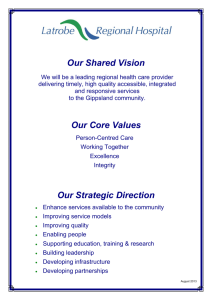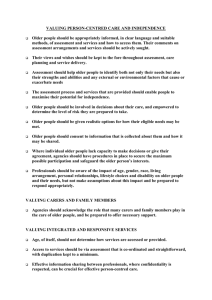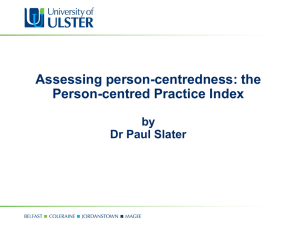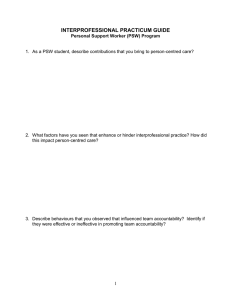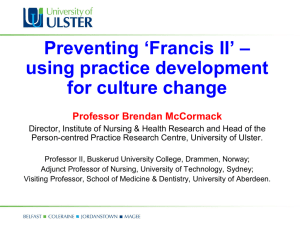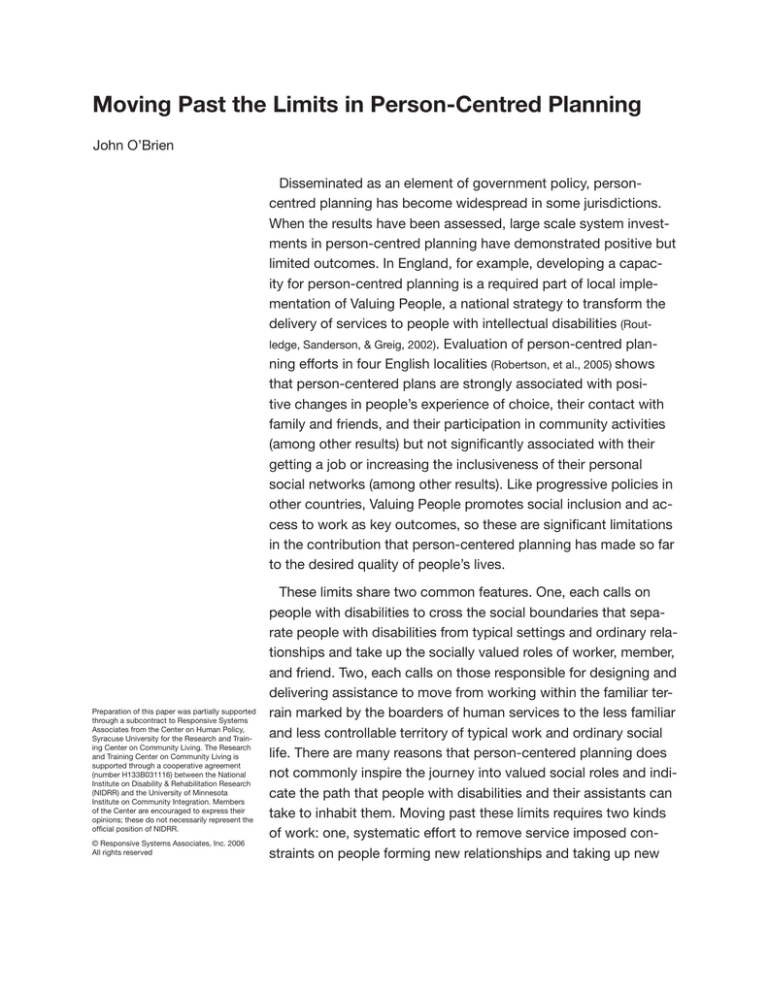
Moving Past the Limits in Person-Centred Planning
John O’Brien
Disseminated as an element of government policy, personcentred planning has become widespread in some jurisdictions.
When the results have been assessed, large scale system investments in person-centred planning have demonstrated positive but
limited outcomes. In England, for example, developing a capacity for person-centred planning is a required part of local implementation of Valuing People, a national strategy to transform the
delivery of services to people with intellectual disabilities (Routledge, Sanderson, & Greig, 2002). Evaluation of person-centred planning efforts in four English localities (Robertson, et al., 2005) shows
that person-centered plans are strongly associated with positive changes in people’s experience of choice, their contact with
family and friends, and their participation in community activities
(among other results) but not significantly associated with their
getting a job or increasing the inclusiveness of their personal
social networks (among other results). Like progressive policies in
other countries, Valuing People promotes social inclusion and access to work as key outcomes, so these are significant limitations
in the contribution that person-centered planning has made so far
to the desired quality of people’s lives.
Preparation of this paper was partially supported
through a subcontract to Responsive Systems
Associates from the Center on Human Policy,
Syracuse University for the Research and Training Center on Community Living. The Research
and Training Center on Community Living is
supported through a cooperative agreement
(number H133B031116) between the National
Institute on Disability & Rehabilitation Research
(NIDRR) and the University of Minnesota
Institute on Community Integration. Members
of the Center are encouraged to express their
opinions; these do not necessarily represent the
official position of NIDRR.
© Responsive Systems Associates, Inc. 2006
All rights reserved
These limits share two common features. One, each calls on
people with disabilities to cross the social boundaries that separate people with disabilities from typical settings and ordinary relationships and take up the socially valued roles of worker, member,
and friend. Two, each calls on those responsible for designing and
delivering assistance to move from working within the familiar terrain marked by the boarders of human services to the less familiar
and less controllable territory of typical work and ordinary social
life. There are many reasons that person-centered planning does
not commonly inspire the journey into valued social roles and indicate the path that people with disabilities and their assistants can
take to inhabit them. Moving past these limits requires two kinds
of work: one, systematic effort to remove service imposed constraints on people forming new relationships and taking up new
roles; and, two, learning ways that the person-centred planning
process can mobilize more courageous and creative action.
Constraints on Inclusive Roles and Relationships
Policies are incoherent. Common examples: benefits systems
create disincentives to employment; schemes for risk management inhibit ordinary relationships; and labor agreements conflict
with workers re-skilling and re-deploying outside the walls of
services that congregate and control people.
Incoherent policies
Many available services are not designed to provide tailored
supports to people in valued roles in ordinary settings. Instead,
they are frequently designed as machine-bureaucracies whose
products are the physical care, supervision, or instruction of
people in groups and whose processes churn on mindless of the
values they are supposed to serve. Existing supported employment services are often unable and unwilling to assist people with
substantial impairments to find jobs that match their interests.
Failure to design for individuals
Public funds are limited, often inflexible in their uses, and usually beyond the effective control of the people who are served
by them. Absent individual budgets that are easy for people to
get and use, it is hard for people and their allies to make up for
mis-matches between their needs for assistance and what current services offer or to meld available natural supports, benefits,
and mainstream resources with a fair allocation of service related
funding to make the best of what is available (Duffy, 2005).
Rigid funding that drives control
Ordinary people and workplaces are often perceived to be unwelcoming to people with disabilities if not downright dangerous
to them. It is often difficult to think about risks. Because settings
and people outside services are unknown before a person engages them, its easy to inflate the dangers of moving beyond a familiar routine and discount the lost benefits of sticking with familiar
settings and roles. Uncertainty about the possibility of success in
building a more inclusive social network or taking a job can lead
people to leave these good things off their list of chosen goals or
even to explicitly choose not to pursue them. This can seem like
a bind to support workers who want to promote inclusion and to
respect people’s choices and avoid imposing on them. It can also
Ordinary people & places seen as
Moving Past the Limits – 2
of people
hostile
seem like a relief if the choice to avoid new roles and relationships
allows support workers to stay in their own comfort zones.
Stuck in the first steps
There is, as the evaluation research shows, substantial opportunity in people’s lives to improve such important matters as choice,
contact with family and current friends, and community activity without reaching out to take up new roles with new people.
Stimulating people to pick this low hanging fruit can generate high
levels of satisfaction with person-centred planning as it is, with
the limited results it creates.
To follow the path of least resistance, accept these constraints
as limiting conditions on person-centred planning, justify ignoring the policy objectives of access to work and more inclusive
social networks as reflecting people’s choices or as unrealistic
fantasies, and focus on making planning meetings enjoyable (and
brief). To make person-centred planning more effective, focus on
learning how planning can contribute to building the courage and
imagination necessary to generate paths to good jobs and greater
inclusion, encourage work toward difficult goals, and advocate to
dissolve, or at least loosen, constraining conditions.
Straightening the way to positive roles and relationships
Changes in the way the service system functions will increase the
number of people who have good jobs and more inclusive social networks by reducing the constraints that people experience
from incoherent policy, services that congregate people, inflexible
patterns of assistance, and demoralizing habits of social exclusion. Widespread limits in the results of person-centred planning
strengthen the case for changes along the following lines and
should motivate those who facilitate person-centred planning to
add their energies to those of other advocates for a straighter,
simpler way to community inclusion.
Dignity of risk
Concerns for safety, health and privacy, and procedures for risk
management have slipped their mooring to commonsense and
float aimlessly in many disabled people’s lives, blocking the channels to full community life. Responsible person-centred planning
identifies people’s vulnerabilities and designs intelligent responses
to them, but the larger context of action needs to shift from atMoving Past the Limits – 3
tempts to bureaucratically protect every detail of people’s lives to
a search for ways to offer people the dignity of risk.
Efforts continue to unpick the knots that entangle people in
avoiding income for work that they can do in order to maintain
benefits that pay for disability related supports that are to costly
to afford on the salary they can earn.
Reduce disincentives to work
There is much more to learn about providing individually tailored
supports in ways that allow people with substantial impairments
to succeed in jobs that match their interests and build stronger
and more inclusive social networks, but much more is known
about how to provide supports for personal inclusion, than is
commonly practiced (see, for examples, Fratangelo & Strully, 2002; O’Brien
& Lyle O’Brien, 1998).
Apply what’s known about indi-
Individual budgets that allow people to exercise effective control over their supports accord people the dignity of responsibility
for deciding how to make the best use of their fair share of public
funds and increase the flexibility with which people can focus
their paid assistance on helping them occupy roles that matter to
them. (For a thorough and thoughtful approach to self-directed
services, see www.in-control.org.uk)
Individual budgets
Many communities and some governments invest in ways to
overcome social exclusion and open the responsibilities and benefits of citizenship to people who have historically been marginalized (O’Brien & Towell, 2005). Aligning with these efforts will energize
and extend the work of overcoming social distance.
Connect with other efforts to
Social devaluation and prejudiced behavior are enduring, exhausting realities, but these monsters need not block all paths
to valued roles and good relationships. Systematic investment in
structures like Partners in Policymaking (www.partnersinpolicymaking.com) that promote person-to-person and family-to-family
learning about what is possible and how other people with disabilities have found their way into work and other valued social
roles. These forms of learning strengthen people’s desire and
resolve as it expands their sense of what is possible and informs
their efforts.
Moving Past the Limits – 4
vidualized supports
reduce social exclusion
Build demand by learning about
what is possible
Strengthening Person-Centred Planning
The key question
The desire to experience a good life in a society and system that
aspires to inclusion but too often operates to produce segregation
sharpens the life-question that person-centered planning wants
to help people explore. Reducing the constraints on finding a way
to valued roles and relationships reduces the drag on a person’s
life, but it leaves a central question pending. That central question is, what particular conditions allow this unique person to
show up in ordinary life as a contributing citizen and a valued
friend?
Fortunately, the way to a good enough answer to this question is
not as ponderous as the question sounds. In fact, if the question
is approached competently, there is often enjoyment as well as
power in pursuing it. Enjoyment flows from the camaraderie that
grows as people work hard to honestly explore important matters
together, even when those matters have painful or frightening or
angry aspects. The power comes from the alignment of energy
that results when a group of people generate clarity about possibilities for action that embodies their highest purposes.
There are several reasonable approaches to person-centred
planning, and each is as capable of liberating the power that
comes from faithful exploration of the central question as it is of
slipping off into debate about less vital and less powerful questions. The differences among approaches chiefly lie in the sort of
information people attend to as they seek the clarity that demands
positive action. Under one approach, a group may look attentively
at the person’s preferred ways of making their way through life’s
routines. Under another, they may seek aesthetic expression of a
person’s identity and highest possible future. Under another, they
may carefully work their way through a person’s history. Under
another, they may draw an arrow to the heart of a hopeful goal.
Under another, they may listen to a person’s dreams and nightmares for the seeds that can grow into a contributing life.
Four kinds of knowledge
Whether a plan leads to positive action or not depends on the
ways that four kinds of knowledge come together: knowledge of
the person’s gifts, capacities, and dreams; knowledge of what
values the person wants to steer her or his life by; knowledge of
Moving Past the Limits – 5
A
s
ties & dr
ea
Values
p a ci
ca
s
ilit
ie
nc
e
m
sib
s fo
• Does the person at the center either originate
or accept the invitation to plan (or is planning a ritual required
by the service system that will go on even in the person’s absence)?
• Do the people who gather to plan come with an openness to
a different future for themselves (or do they imagine that the
person the sole object of change)?
• Does the group have sufficient leadership to face the hard
work necessary to achieve the clarity that demands action (or
is this simply one more task assigned to an over-burdened
functionary)?
• Does the group include people with some awareness of the
possibilities for individually tailored supports (or will people assume that the limits of their current situation exhausts what is
possible)?
• Does the group include people who want the person at the
center to experience the good things that come from valued
social roles and an expanding social network (or do people see
the person as well served if kept healthy and safe)?
• Does the group include people with some awareness of community opportunities (or do people assume that the world
defined by services is sufficient)?
Moving Past the Limits – 6
community op
po r
tun
itie
Gi
ft
s
Po
How these different sorts of knowledge
emerge, shape and blend with each other to generate positive action depends on how well the
planners can create positive answers to at least
six questions.
w
of
ess
n
are
s,
the possibilities for supporting the person’s participation and contribution through such strategies as arranging adjustments to the physical or
social environment, using adaptive equipment,
offering systematic instruction, and providing
tailored personal assistance; and knowledge of
community opportunities.
r acc
ommodation
a
ist
ss
a
&
What makes person-centered
planning work
These six questions remain alive from the moment the idea
of planning comes up until action toward new possibilities produces new experiences. Actions taken in preparation for a planning meeting can greatly increase the odds of positive answers,
but accepting or declining the invitation to plan can shift as the
process unfolds and so can openness to change, awareness of
possibilities and opportunities, and the leadership to mobilize
creative action. Like any performing art, person-centred planning
draws some of its energy from living with the risk that the company might not be able to synchronize it’s moves when the curtain
goes up.
I am grateful to the 2004
participants in my University
of Salford Graduate Seminar,
Organizing to Encourage Effective Direct Support, whose
reflections on their learning
projects collided with my
reading of Otto Scharmer’s
description of the U-Process
and begin my exploration
of mapping person-centred
action in terms of Scharmer’s
framework. What follows is
my attempt to understand my
work by adapting Scharmer’s
terms to my own experiences
of facilitating person-centered
plans when things flow (and
sometimes they do not). He
isn’t responsible for any confusion that I create here and,
while I acknowledge his work,
I recognize that he might
be appalled by how poorly
I understand its subtleties.
See Scharmer, 2007 www.
presencing.com
1
One way to improve the chances that person-centred planning
will lead to positive action is to complement efforts to refine the
various approaches with a search for fruitful ways to understanding the process of generating new possibilities. One such way of
understanding is called the “U-Process”, an understanding of social creativity developed by Otto Scharmer. The rest of this essay
will explore its relevance to person-centred planning.1
The U-Process raises an important question. Will we find what
we desire by proceeding in a straight line from where we are,
taking our direction from our past and doing more of what we are
already doing, or do we need to invest time and energy in moving
beneath the surface of our current understanding of the person
and the possibilities for action? Experience shows that people can
spend a great deal of time and money on person-centred plans
that proceed forward in a linear way without producing what we
desire –a substantially greater number of people succeeding in
valued social roles and enjoying a widening social network. What
we desire embodies a purpose above what we can reach by moving straight ahead. To reach higher, we will have to move deeper.
Moving Past the Limits – 7
Learning
new
ways
More of
the
same
Deeper
understanding…
…and a powerful
desire to act
…generates new
possibilities…
The first step deeper opens us to a new understanding of
this person in the context of ordinary community life: a better
glimpse of the person’s identity, capacities, gifts, and dream. This
is a process of gathering-in all sorts of information by carefully
observing the impressions of the person and the connections
among impressions. This is a moment of collecting and contemplating the words and images and intuitions about the person and
their relationships and roles that the circle can hold in common.
The crucial turn comes when the group purposely opens to the
future. Asking, with openness, what good things can come to
be for this person if the person and all those gathered with him
or her act from their highest sense of purpose invites a desirable future into the circle. New possibilities typically emerge as a
commonly felt sense of direction rather than as a detailed architectural model. The feeling is, “this is the way for this person to
move forward in life” .
The test of how carefully the circle2 has formed its understanding of the person and how open the members of the circle have
been to higher purpose is the strength of the desire to act to realize the new possibility. When the process is at its best, this desire
is not simply for a baby step toward the desirable future, it is a
Moving Past the Limits – 8
Collect & contemplate
Open to highest purpose
As I use it here, “circle” simply refers to those who gather
to plan. The content the group
considers –like each of the
other moves depicted below–
is shaped by the approach
to person-centred planning
the circle follows. I have not
tried to map the steps of any
particular approach onto the
U-process, just my experience of how the process
sometimes goes when a
group is at its best, regardless
of approach.
2
Create a new opportunity
hunger for a prototype experience: something that we can do together that will embody the new possibility, even if briefly, partially,
or symbolically. We want a memory of at least a tracing of the new
possibility as soon as we can have one.
together
The U-Process can’t be forced, but there are disciplines that will
encourage the emergence of a strong desire to learn new ways.
Learning
new
ways
Suspend
“downloading”
Hold space to
listen & think with
whole body
Invoke
courage
to act
Deeper
understanding…
More of
the
same
…and a powerful
desire to act
Allow highest
purpose
to emerge
…generates new
possibilities…
Stop MOTS (repeating “More of
the Same)
To move below the surface of the straight line to more of the
same, the circle practices suspending “downloading”. The term
suggests a computer program downloading a module that will
allow the routine performance of a defined task: more of the
same, over again. A person-centered planning group is downloading from the prevailing human service culture when it organizes
information about the person in a way that slots the person into
something that is already available (or available after a wait or
the location of more funds or a minor modification) –more of the
same. “She is ready for a referral to supported employment.” “We
need the volunteer coordinator to locate a befriender for him.” “He
needs a change in his morning routine.” A person-centred planning group is downloading from consumer society when discovering people’s desires for consumer experiences, like a trip to
Disney World, satisfies the group that a full understanding of the
Moving Past the Limits – 9
person’s dreams has been achieved. A person-centred planning
group is downloading from a disability devaluing culture when
it is too timid to imagine the person taking up a valued social
role and angrily defensive of its low expectations for the person.
Constant sorting into binaries accompanies downloading. The
discussion bounces between poles as people disagree about
whether a suggestion is unrealistic/realistic; unaffordable/affordable; right/wrong.
To create a deeper understanding, the circle practices holding
a space that allows whole-body listening and thinking. The gift
of the idea of whole-body listening, and the most concise expression of it that I know, came to me from Christine Meyer, who
summarized, in these words, what she has learned from years of
struggles in company with people committed to offering her good
support (O’Brien, Lyle O’Brien, & Jacob, 1998, p. 71):
Make a place for listening
deeply
If you are going to work with me, you have to
listen to me.
And you can’t just listen with your ears,
because it will go to your head too fast.
If you listen slow, with your whole body, some
of what I say will enter your heart.
Whole-body listening to the person builds a shared sense of
this unique person. Patterns that bring out important themes
in the person’s life begin to emerge, usually with the support of
graphic facilitation. These patterns become more vivid and deeper as the circle draws forward knowledge of potential community
opportunities and knowledge of possibilities for support and as
people speak up for the value of challenging social exclusion by
claiming valued social roles.
As awareness of life themes, opportunities, and possibilities
for support inter-weave it becomes possible to ask, “What is
the best future we can imagine for this person, a future that the
person and all of the circle members would feel proud to work to
create, a future that would express this person’s highest purpose?” Finding a good answer to this question requires a silence,
a moment in which the people in the circle rest from the compul-
Moving Past the Limits – 10
Listen to the best possible
future
sion to download a quick fix and listen to the future. This notion of
listening to the future sounds more abstract than it is. It is in fact
a felt sense that this expression points to the next important step
in the person’s life journey, and that this step offers the person the
best possible chance to show up among other people as a contributing citizen and a valued friend.
Make definite promises &
agree to support one another
to keep them
Sensing the next step toward good things in life is one thing.
Taking that step is another. Taking the next step engages all the
constraints and contradictions that shape the person’s world.
Some of these constraints and contradictions are internal: habitual ways that we nail our own feet to the floor at the moment we
want to dance. Others are external: social and systemic expressions of the prejudice that faces disabled people as they claim
their rightful places in the world. Before breaking the planning
circle, people will summon their courage by committing themselves to taking action and supporting one another to deal with
contradictions and constraints.
Reach out
Almost always this action includes engaging people outside the
planning circle, discovering more detailed knowledge, gathering
resources, and making–trying–revising more detailed action plans
in order to figure out how to follow the direction that the personcentred plan indicates. As thoughtful action allows exploration of
the direction that emerged from the plan, that sense of direction
grows and changes.
Overcoming the limits in the current practice of person-centred
planning involves both change in the service system and development of the strengths in person-centred planning. One approach
to improving person-centred planning is to increase the number of
ways we can represent the flow of an effective process for social
innovation. The U-Process suggests both a way to understand
the process of person-centred planning and a set of disciplines
whose practice stand a good chance of improving its power to
summon creative and courageous actions.
Moving Past the Limits – 11
References
Duffy, S. (2005) Keys to citizenship (Second edition). Birkenhead,
UK: Paradigm. www.paradigm-uk.org/
Fratangelo, P. & Strully, J. (2002). The challenges of person-centered work. In J. O’Brien and C. Lyle O’Brien, Eds. Implementing person-centered planning: Voices of experience.
Toronto: Inclusion Press Pp. 355-372. www.inclusion.com
O’Brien, J. & Lyle O’Brien, C. Members of each other. Toronto:
Inclusion Press. www.inclusion.com
O’Brien, J., Lyle O’Brien, C,, & Jacob, G. (1998). Celebrating the
ordinary: The emergence of Options in Community Living
as a thoughtful organization. Toronto: Inclusion Press. www.
inclusion.com
O’Brien, J. & Towell, D. (2005). In the mainstream of life? People
with intellectual disabilities and the national policy agenda.
London: Centre for Inclusive Futures.
Robertson, J., Emerson, E., Hatton, C., Elliott, J., MacIntosh,
B., Romeo, R., Knapp, M., Sanderson, H., Routledge, M.,
Oakes, P. & Joyce, T. (2005). The impact of person-centred
planning. Lancaster: Institute for Health Research, Lancaster
University. www.learningdisabilities.org.uk
Routledge, M., Sanderson, H., & Greig, R. (2002) Planning with
people. In J. O’Brien and C. Lyle O’Brien, Eds. Implementing person-centered planning: Voices of experience. Pp.
373-390.
Sanderson H., Kennedy J, Ritchie P. and Goodwin G. (1997)
People, plans and possibilities: exploring person-centered
planning. Edinburgh: Scottish Human Services Trust.
Scharmer, C.O. (2007) Theory U: Leading from the future as it
emerges. Cambridge:SoL www.presencing,com
Moving Past the Limits – 12

